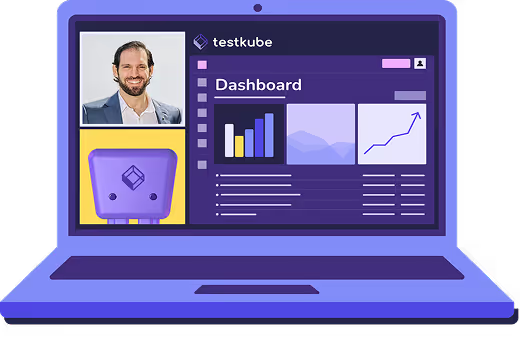

You're doing a really cool job because what you have done has no parallel. You are the only Kubernetes-native Testing platform. Especially with testing workflows. That’s what I love.


Table of Contents
Overview
TomTom, a global leader in navigation technology, has successfully integrated the open-source version of Testkube into its testing workflows. On Iakim’s initiative, the B2C IAM team transitioned from legacy virtual machine-based testing environments to a modern, Kubernetes-based testing infrastructure, significantly improving efficiency and automation in its quality assurance processes.
Challenges Before Testkube
Before adopting Testkube, B2C IAM team faced several key challenges:
- Testing was performed on three expensive virtual machines with no version tracking.
- Test scripts were manually triggered, leading to inefficiencies and delays.
- Integration of testing frameworks into CI/CD pipelines was complex.
- Limited visibility into test results across environments.
Implementation of Testkube
1. Transition to Kubernetes
Iakim spearheaded the migration from standalone virtual machines to a cloud-based Kubernetes platform. This move centralized TomTom’s testing infrastructure, enabling better scalability and automation.
2. Testkube as the Core Testing Framework
Testkube was integrated into TomTom’s Kubernetes clusters, running across development, testing, acceptance, and production environments. The integration was done in several phases:
- Functional Testing: Testkube was used to execute SOAP UI tests for authentication and authorization functionalities.
- Performance Testing: The company incorporated JMETER for load, stress, and soak testing.
- Selenium-Based UI Testing: Java-based Selenium tests were developed and integrated using Maven, allowing automated UI validation.
3. Integration with CI/CD Pipelines
Initially, Testkube was triggered via Azure DevOps pipelines. However, as TomTom moves towards GitHub Actions, the plan is to transition Testkube triggers to GitHub-based workflows, streamlining execution across the company’s evolving CI/CD framework.
4. Log Management and Monitoring
To enhance test result visibility and debugging capabilities:
- Logs from Testkube executions were integrated with Prometheus-stack for monitoring.
- Log management tools provided engineers with detailed execution traces.
- Engineers could now track issues from test execution to application logs, significantly reducing troubleshooting time.
Key Benefits Achieved
- Cost Reduction: Eliminated the need for dedicated virtual machines, saving infrastructure costs.
- Scalability: Tests are now infrastructure-as-code, ensuring seamless execution across environments.
- Automation & Efficiency: Reduced reliance on manual testing, enabling faster software releases.
- Improved Debugging: Enhanced log visibility and error tracking streamline troubleshooting efforts.
Future Roadmap
Expanding Testkube’s role within TomTom by:
- Advocating for company-wide adoption of Testkube as a standard testing solution.
- Engaging with platform engineering teams to integrate Testkube into broader infrastructure projects.
- Exploring the potential of Testkube's commercial version to unlock advanced parallelization and execution optimization.
Conclusion
TomTom’s adoption of Testkube’s open-source version has been a game-changer in automating and streamlining its testing processes. With a strong foundation in place, the company is poised to further enhance its testing capabilities and drive even greater efficiencies in software quality assurance.
This case study highlights how an industry leader like TomTom successfully utilizes Testkube at scale, offering valuable insights for other enterprises considering similar testing transformations.
About Testkube
Testkube is a cloud-native continuous testing platform for Kubernetes. It runs tests directly in your clusters, works with any CI/CD system, and supports every testing tool your team uses. By removing CI/CD bottlenecks, Testkube helps teams ship faster with confidence.
Explore the sandbox to see Testkube in action.



.avif)

